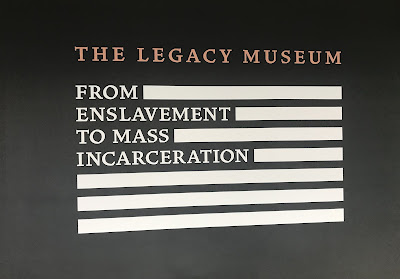A visit to the National Memorial For Peace and Justice is a must stop on the Civil Rights Trail. If you have read the book, or watched the movie Just Mercy you will know Bryan Stevenson and the Equal Justice Initiative.
The visit encompasses the Memorial, and the Legacy Museum located near each other in downtown Montgomery. We had planned to visit both on the same day. We spent 6 hours moving through the Legacy Museum and 3 more two days later. The following day, we spent another 3 at the Memorial. To understand, you have to visit. Though to get an idea, follow the links to the videos on the Memorial webpage. Photography isn’t permitted in the Museum so these videos serve as a preview.
 The Legacy Museum opened, in October of 2021, tells the comprehensive story of the international and domestic slave trade in the building of this country. It chronicles the legacy of emancipation and reconstruction, and the violent response to setting black Americans free, and how intimidation, violence and lynching reinforced segregation in the south. Next it recounts the fight for civil rights and how mass incarceration and criminal justice have effectively worked to reinforce white supremacy.
The Legacy Museum opened, in October of 2021, tells the comprehensive story of the international and domestic slave trade in the building of this country. It chronicles the legacy of emancipation and reconstruction, and the violent response to setting black Americans free, and how intimidation, violence and lynching reinforced segregation in the south. Next it recounts the fight for civil rights and how mass incarceration and criminal justice have effectively worked to reinforce white supremacy.
The museum sits on the site where Black people were warehoused, sold, and forced to work. The story is told through art, film, images and first person narratives.

 |
| A Reflection Pool in Remembrance of those Black people who were lynched in the over 4,000 know acts. |


 The National Memorial for Peace and Justice was opened in April of 2018. Through the work of the Equal Justice Initiative, researchers have documented 4,400 cases of racial terror lynchings during the post-Reconstruction era, between 1877 and 1950. These lynchings were witnessed by as little as two, to as many as 10,000 individuals.
The National Memorial for Peace and Justice was opened in April of 2018. Through the work of the Equal Justice Initiative, researchers have documented 4,400 cases of racial terror lynchings during the post-Reconstruction era, between 1877 and 1950. These lynchings were witnessed by as little as two, to as many as 10,000 individuals.
The Memorial sits on a six acre site and consists of 805 hanging steel rectangular columns. Each steel column represents the counties where lynchings occurred, with the names and dates of those lynched inscribed. Where the name of the victim is unknown, that is what you read. Some counties reflect only one, and some more than 200 events. A docent at the Memorial suggested that we note the date, and then the last names that appear on the column. Those sharing the same date indicate a mass lynching. Those sharing a last name reflects an entire family. To be clear, only known and documented events are represented on these columns.

 |
This Kwame Akoto-Bamfo sculpture is a part of his larger Nkyinkyim Installation. His powerful sculptures are featured here and in the Legacy Museum.
|





 |
| Only a few of the stories are told along this corridor |







 |
| My home state is not without guilt |
 |
| For those who walked during the Montgomery Bus Boycott |
 |
| Across the street from the Memorial the Center lists names of those Lynched beginning in 1950. I also displays soil collected through the Community Soil Collection Project from those lynchings that took place in Alabama. |
 The Legacy Museum opened, in October of 2021, tells the comprehensive story of the international and domestic slave trade in the building of this country. It chronicles the legacy of emancipation and reconstruction, and the violent response to setting black Americans free, and how intimidation, violence and lynching reinforced segregation in the south. Next it recounts the fight for civil rights and how mass incarceration and criminal justice have effectively worked to reinforce white supremacy.
The Legacy Museum opened, in October of 2021, tells the comprehensive story of the international and domestic slave trade in the building of this country. It chronicles the legacy of emancipation and reconstruction, and the violent response to setting black Americans free, and how intimidation, violence and lynching reinforced segregation in the south. Next it recounts the fight for civil rights and how mass incarceration and criminal justice have effectively worked to reinforce white supremacy.

 The National Memorial for Peace and Justice was opened in April of 2018. Through the work of the Equal Justice Initiative, researchers have documented 4,400 cases of racial terror lynchings during the post-Reconstruction era, between 1877 and 1950. These lynchings were witnessed by as little as two, to as many as 10,000 individuals.
The National Memorial for Peace and Justice was opened in April of 2018. Through the work of the Equal Justice Initiative, researchers have documented 4,400 cases of racial terror lynchings during the post-Reconstruction era, between 1877 and 1950. These lynchings were witnessed by as little as two, to as many as 10,000 individuals.






























Comments
Post a Comment